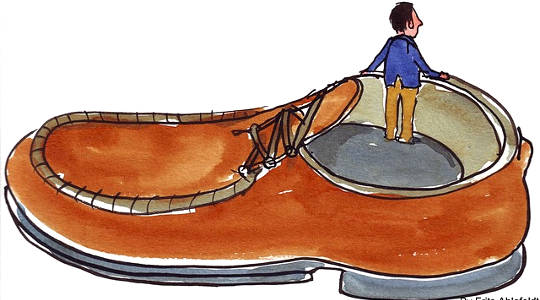
Ultimately, it is not what we think or say that determines our reality but what we are or are not capable of doing. Each time we experience failure on the path to a goal that is close to our hearts we face the ultimate trap of the acquired personality: the failure neurosis.
This can take different forms, from the most flagrant to the most subtle. At the moment that we think we have succeeded, we encounter an interior or exterior obstacle that calls this apparent success into question. Accident, depression, helplessness, procrastination, paralysis—the conclusion is always the same: “I can’t do it.”
Sabotaging the Success of Your Effort?
The failure neurosis can also express itself in a collective enterprise, such as when someone suddenly throws himself headlong into conflict with another, immobilizing the joint effort, or when a person decides to leave a cooperative, knowing very well that her departure will produce a crisis that will damage the success of the work.
The failure neurosis also manifests when, once the work is produced, one retrospectively demolishes it, perhaps by falling into a deep depression, or by sabotaging whatever is left to sabotage, like the publicity that will carry the project to the world.
The failure neurosis expresses itself as an indefinable malaise, feelings of guilt, the notion that one is ugly or incompetent in spite of all objective proof to the contrary. In extreme cases, the person kills himself or sinks into madness after having attained his goal.
Six Main Causes of Being Driven to Failure
Under all these faces, one is driven to failure by six main causes, six beliefs that are encrusted in the Unconscious. We present each of them below, accompanied by a suggestion for a positive visualization to use to move beyond them.
“I Am Fundamentally Bad.”
Under one pretext or another, the genealogy tree did not accept me for what I was. The clan wanted a child of the opposite sex, of another appearance, with other qualities, quicker, slower, more tranquil, more energetic. This rejection, reiterated many times, deeply affected me and drove me to attempt, without success, to be what the tree wanted me to be.
This was obviously impossible because I can only be myself. However, at any given moment of triumph when I gave myself the right to exist just as I am, I tried to drive myself to failure—making the clan right about me.
Positive visualization. I imagine the whole tree is just like me. What marvelous relationships I would have with each member of the clan if the characteristics held against me were common to everyone. For example, I am delicate and spiritual in a virile and materialistic tree; I imagine the whole clan endowed with my delicacy. I am a girl and they wanted a boy; I imagine the whole tree sensitive to feminine qualities: my father, my grandparents, my uncles, all family members, are endowed with great inner femininity.
“I Was a Burden or an Obstacle.”
The genealogy tree makes me responsible for its own inconsistencies and incapacities. I was born “by accident,” or in a family already mired in material problems. My parents abandoned me into the hands of others or, to the contrary, they claimed to have “sacrificed” for me: they accused me, overtly or not, of preventing them from fulfilling their goals. So I feel incapable of bringing anything good to anyone.
In order not to betray this belief, at any given moment of triumph I sabotage my own success that would be a solution, a joy for the world, contrary to that which identifies me today.
Positive visualization. I am a contribution; with me comes miracles. For example, the moment I was born I imagine my parents received a prize, a government grant, a gift for my birth. If my mother missed a career as a singer because of my birth, I imagine that my mother’s voice mutated in a miraculous way during her pregnancy and that she became a celebrity thanks to me for her golden voice—she even did a duo with me.
“I Do Not Have the Right to Betray.”
The clan apparently accepts me. It is possible that I had a happy childhood. But my existence is based on the condition of loyalty without fail. I must adopt their ideas, their social behavior, their religion, their ideologies, aesthetics, and emotions as mine. In reality, I do not exist and my family does not love me unless I remain a completely supportive, indistinguishable element.
If my mother inculcated me with hate toward men (for a girl), or convinced me that no woman was good enough for me (for a boy), I will make my amorous relationships fail in order to not betray my mother. If my father thinks that all activity outside commerce is unacceptable, I will fail in everything that is not commercial.
National cohesion also functions according to this model. Consequently, I do not give myself the right to live except as an element of the clan, which deep down, absolutely denies my unique existence.
Positive visualization. The whole genealogy tree takes on my new ideas, my new initiatives, my discoveries. For example, if I change my political opinion, they register with my party and vote with me; if I fall in love with a person of another race or religion they fall in love with my partner’s culture or convert to the religion.
“I Do Not Have the Right to Leave.”
Here again, the family ambiance was apparently happy. But my parents raised me not to guide me toward independence but to keep me (actually or symbolically) near them. The deep dissatisfaction of other members of the clan reflects on me.
If I leave my parents, they will die, or (in the case of a parental couple with a sadomasochistic knot) they will kill one another; or else one will sink into a depression. I am guilty. I must put in a lot of effort for everything I have received because I carry an artificial responsibility.
All success is a step toward the world and in effect consists of leaving my family to enter into the human community. Consequently, I am not allowed to triumph.
Positive visualization. All the members of my family go toward an ideal place on the planet, outside of familial roots. I visualize my whole genealogical tree peopling the planet, full of joy, emigrating successfully here and there.
“I Do Not Have the Right to Surpass My Parents.”
I carry my clan’s defeat. Either the clan is composed entirely of failures or there is, among my ancestors, a (generally very narcissistic) “big man” or “exceptional woman” whose success is considered unsurpassable. They inculcated me with limitations for any possible success: it is not possible to be rich, happy in love, talented, adventurous, beyond whatever limits.
If, for example, my father and grandfather were failed doctors who became nurses, dentists, or physiotherapists, I will consciously fail my exams at medical school in order to refrain from showing them that it is possible to succeed, because in exceeding them I would destroy their authority, their superiority established on my voluntary inferiority, and would find myself symbolically to be an orphan. The pain of failure stings less than this abandonment.
Positive visualization. I raise everyone to the level of my own fulfillment. Each, in his own domain, encounters success equal to mine and enjoys his triumphs in the great collective party where everyone accepts success and talent essentially as an individual, and where no one can be compared with anyone else.
“Pleasure Is Dangerous, Dirty, and Prohibited.”
If the genealogy tree suffers from a strong sexual repression, all pleasure will be considered suspect, even diabolical. Generation after generation, my clan prohibits its descendants from enjoying life and their own capacities.
At the moment of triumph this fundamental prohibition descends, preventing access to fulfillment, and can also affect sexuality, causing one to be frigid, impotent, or a premature ejaculator.
Positive visualization. I imagine a huge carnival. My whole family participates, each of us with a costume and a mask that allows us to act out something previously kept secret and prohibited from our personality. Each enjoys the pleasure of this warm, delightful ambiance.
Identify the Failure Neurosis Every Time it Appears
Each time the failure neurosis manifests it causes the individual to lose sight of his goal and the mission of his particular life that only he has the power to realize.
The basis of the failure neurosis is a devaluation of self, based on family membership, which resides in us as orders and prohibitions. At the end of the day, we feel empty. The only way to radically oppose this harmful illusion is to accept the inner diamond, our own essential value, and to draw from the source of ourself this unalterable happiness that resists all obstacles.
But the real work on the failure neurosis consists of identifying it whenever it is found at the crossroads, each time it appears. One can then consciously choose to be driven by or to turn away this failure, this call from the past.
Choose to Be True to Your Self
Triumphing in a true vocation is the greatest pleasure there is. Our clan has asked us to be something other than be ourselves, and in yielding to this order we have lost sense of what we truly are. The acceptance of one’s self is heroic because it means the collapse of inner restrictions created by the family, society, and culture.
Our acquired identity is always insufficient and defective: it is the container and not the contents. But the collapse of these worthless remains, or the crack in this mask, terrifies us and we tend to reject it. Our greatness, our capacity to shine, to love without limits, to triumph, is more frightening than our smallness.
To overcome this fear implies having a more elevated purpose. We can call it love of oneself, love of the work that we are in the process of accomplishing, love of all those whom this work will benefit. It is therefore when gratitude enters the game, when we accept the collapse of the limited me, when we enter into contact with gratitude and grace. This essential appreciation opens the path to our own qualities.
We have presented the hypothesis that we carry the future within us, that our brains are potentially limitless, just as the universe is, and have more capability than we use. The future is therefore inside us, like an immense reservoir of potentiality, and we can postulate that there exists in us an energetic destiny inviting us to become that which we are able to be, guiding us toward positive fulfillment.
Reprinted with permission of the publisher, Park Street Press,
an imprint of Inner Traditions Inc. www.innertraditions.com
©2011 by Alejandro Jodorowsky and Marianne Costa.
English translation ©2014.
Article Source
 Metagenealogy: Self-Discovery through Psychomagic and the Family Tree
Metagenealogy: Self-Discovery through Psychomagic and the Family Tree
by Alejandro Jodorowsky and Marianne Costa.
Click here for more info or to order this book on Amazon.
About the Book's Authors
 Alejandro Jodorowsky is a playwright, filmmaker, composer, mime, psychotherapist, and author of many books on spirituality and tarot, and over thirty comic books and graphic novels. He has directed several films, including The Rainbow Thief and the cult classics El Topo and The Holy Mountain. Visit his Facebook page at http://www.facebook.com/alejandrojodorowsky
Alejandro Jodorowsky is a playwright, filmmaker, composer, mime, psychotherapist, and author of many books on spirituality and tarot, and over thirty comic books and graphic novels. He has directed several films, including The Rainbow Thief and the cult classics El Topo and The Holy Mountain. Visit his Facebook page at http://www.facebook.com/alejandrojodorowsky
 Marianne Costa has worked with Jodorowsky since 1997, coteaching workshops on Tarot and metagenealogy. She is the author of No Woman's Land and the coauthor of The Way of Tarot.
Marianne Costa has worked with Jodorowsky since 1997, coteaching workshops on Tarot and metagenealogy. She is the author of No Woman's Land and the coauthor of The Way of Tarot.
Watch a video (in French with English subtitles): Awakening our Consciousness, by Alejandro Jodorowsky.




























